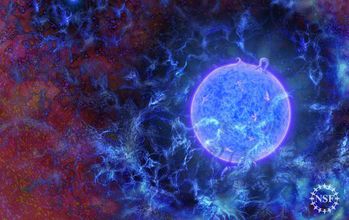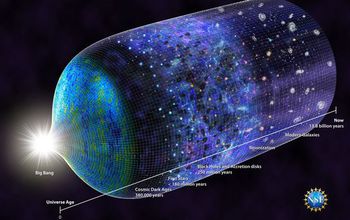All Images
News Release 18-013
Astronomers detect ancient signal from first stars in universe
Within 180 million years of the Big Bang, stars were born
This material is available primarily for archival purposes. Telephone numbers or other contact information may be out of date; please see current contact information at media contacts.

This artist's rendering shows the universe's first, massive, blue stars embedded in gaseous filaments, with the cosmic microwave background just visible at the edges. Using radio observations of the distant universe, NSF-funded researchers Judd Bowman of Arizona State University, Alan Rogers of MIT and their colleagues discovered the influence of such early stars on primordial gas. Although they can't directly see the light from the massive stars, Bowman’s team was able to infer their presence from dimming of the cosmic microwave background (CMB), a result of the gaseous filaments absorbing the stars' UV light. The CMB is dimmer than expected, indicating that the filaments may have been colder than expected, possibly from interactions with dark matter.
Credit: N.R.Fuller, National Science Foundation
Download the high-resolution JPEG version of the image. (579.5 KB)
Use your mouse to right-click (Mac users may need to Ctrl-click) the link above and choose the option that will save the file or target to your computer.
NSF's Peter Kurczynski explains how a tiny, refrigerator-sized antenna was able to make the first detection of the universe's original stars. This video is also available for viewing on NSF's YouTube site.
Credit: NSF

This updated timeline of the universe reflects the recent discovery that the first stars emerged by 180 million years after the Big Bang. The research behind this timeline was conducted by Judd Bowman of Arizona State University and his colleagues, with funding from the National Science Foundation.
Credit: N.R.Fuller, National Science Foundation
Download the high-resolution JPEG version of the image. (497.2 KB)
Use your mouse to right-click (Mac users may need to Ctrl-click) the link above and choose the option that will save the file or target to your computer.
